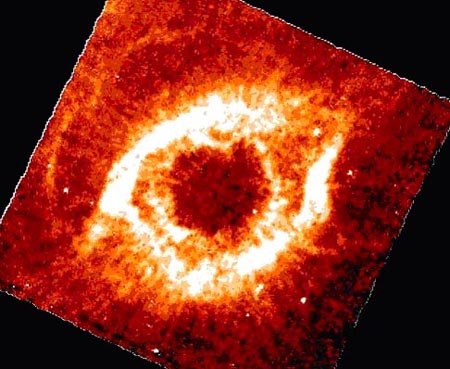Planetary nebulae
|
Planetary nebulae were initially observed by Messier in his famous catalog, more than 200 years ago. Later, the planetary nebulae were separated from the other nebulae, by the fact that they have a certain structure and usually have a central star. The spectrum of the planetary nebula is dominated by emission lines. The first line identified in the spectrum of planetary nebula was hydrogen Balmer line (Hβ), although there were stronger lines in emission spectrum, but they were hard to identify. One solution was that those were lines of previously unknown chemical element "nebulium". Line strength led to the conclusion that these are lines of known elements, but who are under very unusual physical conditions. One of them is a great rarefaction of the interstellar medium. The theoretical consideration of the origin of planetary nebulae started Shklovsky (Shklovsky 1956), who suggested that planetary nebulae are white dwarf progenitors and red giants ancestors. By making connection between planetary nebulae and white dwarfs and red giants, Shklovsky concluded that the planetary nebulae are stars of very fast evolution. Shapes and morphological classification of planetary nebulaeAlthough known for their ring shape, planetary nebulae occur in various forms. Curtis (1918) made the first classification and his sample of 78 planetary nebulae and divided them into classes of the helical, annular, disc-shaped, amorphous and star-like. Later, using radio observations with the VLA interferometer, Aaquist and Kwok (Aaquist & Kwok 1996) made the classification into circular, elliptical, open elliptical, butterfly, and S-asymmetric planetary nebulae. They also concluded that the planetary nebula shape is obtained at the beginning of their evolution. Radiation of planetary nebulaeAccording to the classical static model, planetary nebula consists of two components, the central star and nebular gas around it. Central stars of planetary nebulae are very hot, with the effective temperature of about 105 K, and most of the energy is radiated in the ultraviolet part of the spectrum. Emitted UV photons will ionize the atoms in the nebula. Free electrons will then tend to excite atoms, which previously were not ionized. By spontaneous emission of excited atoms and ions we get a number of emission lines visible in the optical part of the spectrum. Planetary nebulae radiate in all parts of the continuum spectrum, from radio to X range, by different radiation mechanisms. |
Formation rate
Although with a great uncertainty, observations of planetary nebulae in the solar environment give the rate of formation of one planetary nebula per year, and their total number in the Galaxy around the 2500. These numbers are assumed to be ten times higher as a result of difficulty in detection due to the Galactic extinction.
The Σ-D relation
As planetary nebulae radiate in the radio domain (although only 5% of the total number of known planetary nebulae can be detected with radio telescopes), it is possible to derive a theoretical and an empirical relation between their radio surface brightness, created by Bremsstrahlung radiation, and their diameter, also known as Σ-D relation.
|
Line emission of planetary nebulaeOne of the characteristics of planetary nebulae is the presence of numerous and intense forbidden emission lines in the spectrum. Another type of emission lines characteristic for planetary nebulae are recombination lines of hydrogen. Some of the most intense lines in the spectra of nebulae are lines of hydrogen and helium, and ions N+, O+, O++, Ne++, Ne+++, Ar++. Dust emission in planetary nebulaePhotometric observations in the infrared and far infrared part of the spectrum revealed the existence of a strong emission originating from the dust. Observations showed that the dust is cold, with temperatures around 100 K. The discovery of cold dust in planetary nebulae, with the observed dust envelope of AGB stars, shown that they have the same origin – they are consequences of a large mass loss in AGB stars. |
 |
Different shapes of planetary nebulae. |
 |  |
Helix Nebula in the visible and infrared light. | |
The origins and evolution of planetary nebulaeToday it is believed that planetary nebulae originate from double-shell burning AGB stars (asymptotic giant branch). The cores of the central stars are made of degenerate carbon and oxygen, and in the most cases in thin shells around the core the hydrogen is burning. It has been shown that the requirement for the core mass of the central star must be in a very narrow range (0,55 – 0,64 Mo). Although it has been known for long time that red giants are losing mass, only the development of infrared and millimeter astronomy enabled direct observation of material ejection. Speed of mass loss is about 10-5 Mo per year. Mass loss is on until the entire hydrogen envelope is blown away, and until the effective temperature of core increases that much so further mass loss is not possible. This is how the post-AGB phase starts, which continues as the planetary nebula phase. Planetary nebula is not just red giant’s atmosphere that spreads into interstellar medium. Photoionization and strong stellar wind completely transform the interstellar environment after the stage of AGB star. Even the smallest density gradient from equator to pole of the stars while it is in the AGB phase, by using ISW model - "interacting stellar wind" (Interacting Stellar Wind, Kwok et al. 1978), a model which is valid when it comes to the formation of planetary nebulae – can give the elliptical, bipolar, butterfly shaped or a double ring nebula. |
Selected papers




